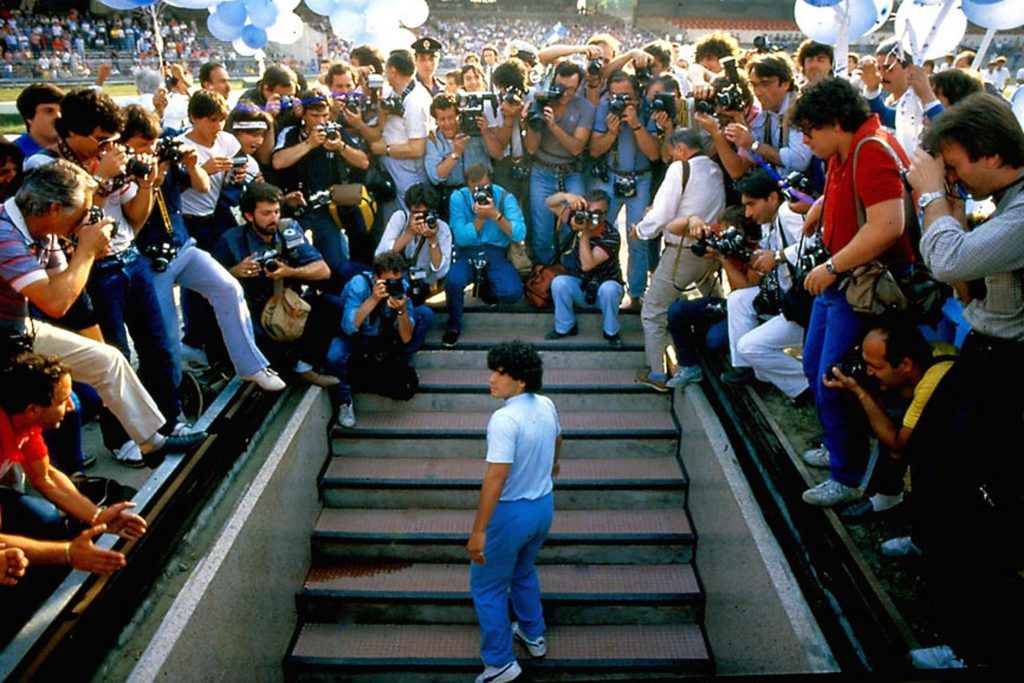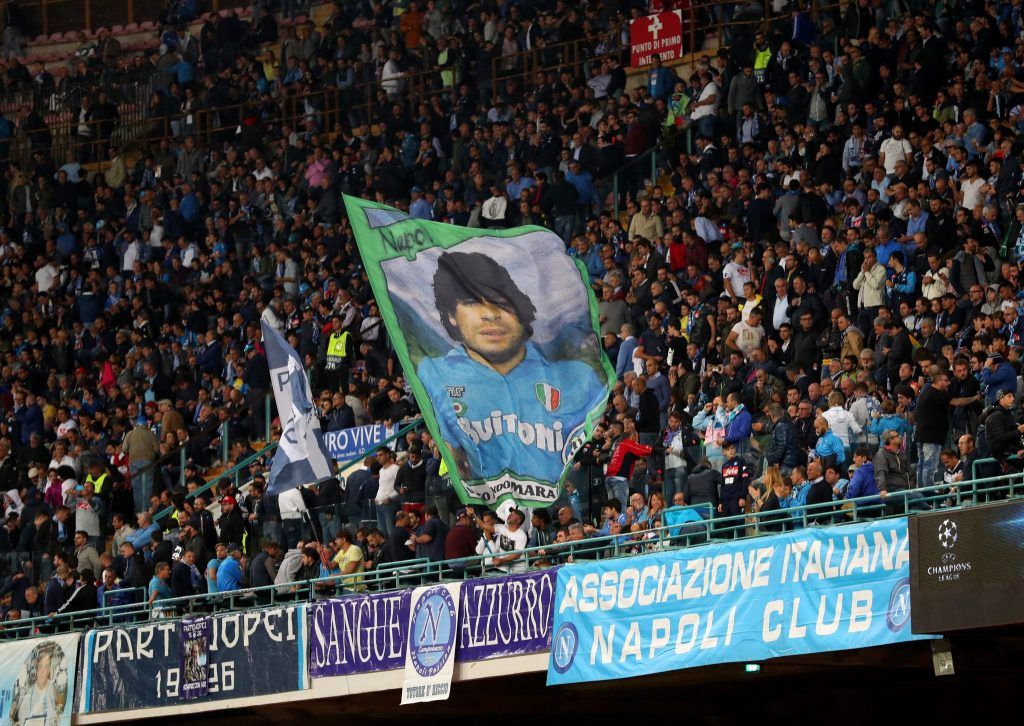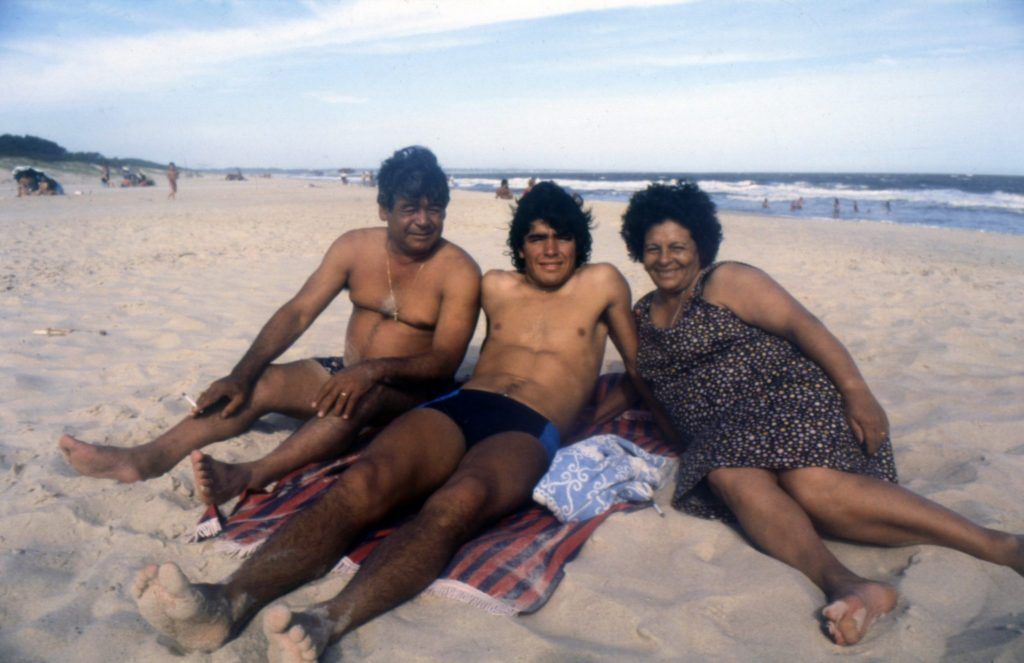It has been nearly three decades since his stay in the city came to an abrupt and controversial end, but in Naples, it’s almost as if Diego Maradona never really left.
Beneath the glass roof of the Galleria Umberto I, a life-size cardboard cutout stands beside the doorway of a small souvenir shop. Inside, an entire corner has been stocked – shrine-like – with Maradona merchandise. There are fridge magnets, shot glasses, scarves and tiny figurines with black hair and white number tens hand-painted on the back of their azure shirts. Similar trinkets are available in just about any of the gift shops dotted around the city centre.
Maradona’s name still appears in graffiti on countless walls and roll-down shutters for miles around; framed photographs of him seem to hang behind every bar. There are murals, too. In the Spanish Quarter he is portrayed in his prime, mid-dribble. In the suburb of San Giovanni a Teduccio, a painting of him in middle-age, hair and beard flecked with grey, surveys his kingdom from the side of a tower block.
Still, after all the years, Maradona remains a Neapolitan obsession.
“Naples and Maradona were made for each other,” Asif Kapadia, director of Diego Maradona, the new film about the Argentine’s seven-year spell in the city, tells us.
“It was both the best and worst place for him.”
Maradona joined SSC Napoli in 1984. He had endured a difficult two years at Barcelona before that where, hindered by injury, he had failed to meet the lofty expectations that came with the then-world record transfer fee they had paid to Boca Juniors.
Though Italy – by this stage the best league in the world – was a logical next step for Maradona, his choice of club came as a surprise. Napoli had narrowly avoided relegation at the end of the 1983/84 season and had never won a league title in their history. They were an unfashionable club from one of the poorest cities in Europe, looked down upon by supporters of wealthier teams from the more affluent cities in the Italian north.
That they could attract one of the finest footballers in the world was seen as a miraculous coup and news of Maradona’s arrival triggered scenes of wild celebration in the streets.
“Neapolitans are very passionate people,” Kapadia explains. “Maradona needed love when he arrived there and they gave him all the love they possibly could. The problem was that, in time, it was suffocating. It became too intense for him.”
Ultimately, as his ubiquity in present-day Naples highlights, Maradona was a success in the city. He played a prominent role in Napoli’s Serie A title wins in 1987 and 1990 and led them to the UEFA Cup in 1989. He was a Napoli player when he helped Argentina to World Cup glory in Mexico in 1986. All of these triumphs contributed to the God-like status he assumed in the city.
Though his on-field achievements are covered, Kapadia’s film is as much about Maradona’s gradual decline, charting his problems with drug abuse and his relationship with one of Naples’ most notorious crime syndicates.
“We did a lot of research on Maradona’s life for the film,” Kapadia explains. “We didn’t just look at his time in Naples.
“You realise when you look at his career that there’s a cycle that keeps repeating itself. There’s hope and celebration when he arrives somewhere, then it goes wrong and falls apart.
“The biggest cycle happened in Naples. That’s where he becomes the best player in the world, wins the World Cup, wins the championship with a team that’s never won anything before… But that’s also where all his problems really started.”
Kapadia first had the idea to make a film about Maradona during the late 1990s after reading Hand of God, the biography by Jimmy Burns. After the release of Senna – his groundbreaking, BAFTA-winning documentary on the late Brazilian Formula One driver Ayrton Senna – he was presented with an opportunity when producer Paul Martin told him about an archive of rare Maradona footage he believed he could access.
“It looked really interesting,” Kapadia recalls. “The thing was, it was around 2012 and I’d just made a film about a Brazilian sporting hero. I wasn’t sure if I wanted to go into making a film about an Argentinian sporting hero straight after that. I thought the timing wasn’t quite right.”
Instead, he turned his attention to making Amy, a biopic about the singer Amy Winehouse for which he would later win an Oscar.
After that, Martin approached him again. On this occasion, having introduced him to his producer, James Gay-Reece, Kapadia decided the time was right. From there, an agreement was reached over the footage and a deal was done with Maradona’s lawyer to secure the rights to make the film.
Despite Maradona’s fame and reputation as one of the most famous sportsmen of all time, Kapadia was excited by the challenge of telling a story that many people thought they already knew.
“You can look back at the other films I made,” he explains. “I made Senna and some people were like ‘I already know this story, what more can you tell me?’.
“I made Amy and people were like, ‘Yeah, I know about her, she was an idiot.’ Actually, no, I don’t think they did know her, and the same thing applied here, to Diego.
“People – younger people, in particular – know latter Maradona. They know the person that came afterwards. It was important to show what came before that as well.
“Most people who think they know this story, actually, probably don’t because most of it wasn’t shown.
“All this happened before the Football Italia years. People in the UK, like me, only knew him every four years when the World Cup was on. People in Argentina said they didn’t see what happened in Naples. People in Naples, who were there, said a lot of the material in this film has never been shown.”
Much of the footage used in the film was shot by two cameraman, commissioned by the late Jorge Cyterszpiler, a friend and agent to Maradona, during the early 1980s.
From the opening scenes, which follow a convoy of Fiats as they weave through hectic Neapolitan streets – one of them carrying Maradona to his unveiling at the San Paolo Stadium – the footage paints a compelling never-seen-before picture of Maradona’s time in Naples. Most of the material is football-related, showing him during games and in training sessions, but there is also a window into his social and family life.
The visual element of the film is accompanied by a number of extensive interviews conducted by Kapadia and his team with Maradona and several of the people who were closest to him during his time in Italy. As was the case in Senna and Amy, there are no talking heads – all audio is played over the footage.
There are plenty of intriguing insights shared by the interviewees, with Maradona’s candid reflections about this period of his life stitching everything together – even if the process of arranging the conversation was far from straightforward.
After being told of a window of availability Kapadia arranged to go to Dubai, where Maradona was living at the time, to conduct the first interview. Taking with him a team including producers, a translator and a cameraman, the meeting was postponed several times. When it eventually reached the last day of their visit, it was finally agreed that Maradona would see them.
“After five days of waiting we were given something like a five-minute meeting and we returned to the UK,” Kapadia recalls.
Thankfully, the director had better luck on his next visit to Dubai, where he was able to conduct the first of a series of in-depth interviews.
“I liked his company,” he says. “He was enjoying the stories he was telling and his eyes were really bright. He’s an excellent storyteller and very charismatic.”
Though Kapadia speaks highly of him, he admits that coaxing Maradona to talk about some of the more difficult topics in the film was a challenge.
“He’s a master of diversion,” he smiles. “I could ask a question about something like, I don’t know, drugs, and he’d go off on a tangent about Sepp Blatter. The story would be great, but it wasn’t really relevant.
“By the final interview I did with him, I had to be quite tough with him to get the information which was relevant to the film.
“One of the questions, he didn’t like. I kept coming back to it because I felt he wasn’t fully answering it. I could see it was irritating him and he ended up saying to me that I had a bit of a nerve asking him it to my face… but that he respected me for doing so.
“It was awkward, though.”
The film makes no attempt to shy away from the more controversial aspects of Maradona’s time in Naples – particularly the way in which it came to an end – painting a real sense of his vulnerability.
In one of the interviews, Fernando Signorini, Maradona’s former personal trainer, can be heard comparing it to dealing with two separate people. There was Diego – innocent, charismatic and instantly likeable – and there was Maradona – unpredictable and devious. Diego, Signorini explains, would be nothing without Maradona, and vice-versa.
Though his chapter in Naples produced the finest moments of his footballing career, it set Maradona on a path to some of his darker moments. In telling this story, Kapadia hopes the film will help people reassess the way in which they look at him, particularly in respect to the headlines he generated during last summer’s World Cup.
“Something happened to him in Naples. Look at the state of him, how utterly lost he is when he leaves.
“I saw the way he was at times in Russia last year and some of the nasty jokes people made about that, but I feel a bit sorry for him when I see him like that. It’s not funny when you see him or anyone else like that.
“Yes, he is this strong, Latin, charismatic hero, but he’s also someone who can’t be in a place where there’s temptation.
“He needs protection. He needs a bit of looking after. I just hope when people see the film, they might think about him in a different way.”
Diego Maradona is out in cinemas on 14 June
https://www.youtube.com/watch?v=JNaRrDX8MUc






















































